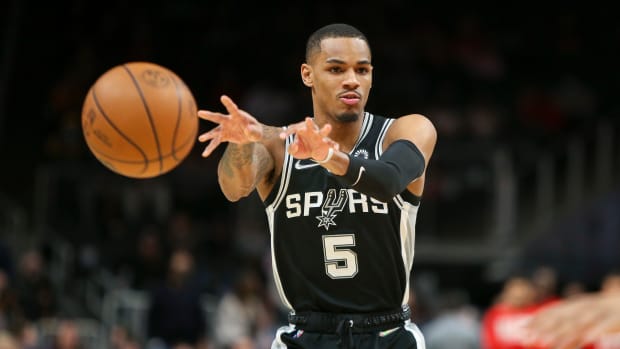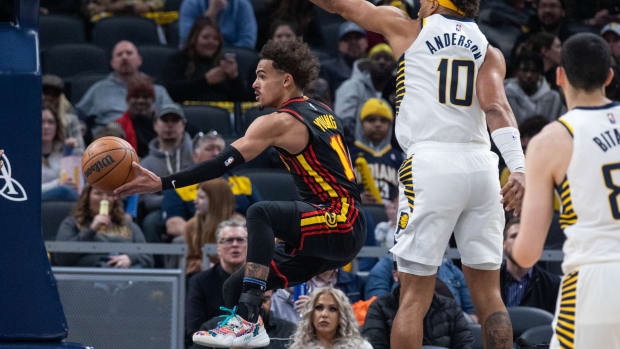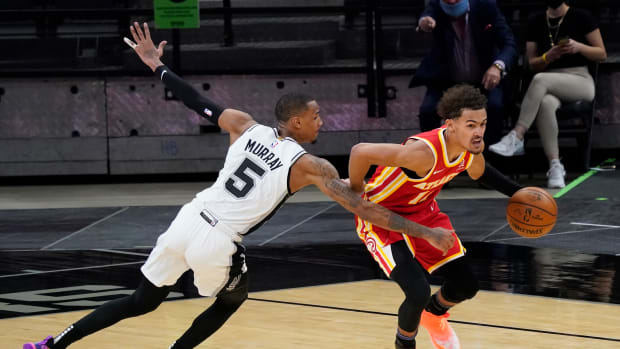Three Keys to Success for Trae Young & Dejounte Murray

With the arrival of former San Antonio Spurs point guard Dejounte Murray, the delicate balance of the Atlanta Hawks starting rotation inevitably changed, and for the better. Murray, who was selected to his first All-Star game last season, really grew into his two-way strengths and will look to generate a significant impact alongside his guard mate, Trae Young.
But this is easier said than done. Seeing that both guards have a) not only different skill sets but b) distinctive experiences from their time in the NBA, uniting them together into the same system will require plenty of work and diligence for this duo to succeed together.
Naturally, building chemistry will take time, and that’s a given. However, understanding how to work with each other’s differences and similarities is something else entirely and a significant challenge for the Hawks starting guards to figure out and manage throughout this season.
On the one hand, you have Murray, a physical, lanky slasher that brings sharp ball handles, great rebounding, strong defense, and astute court vision. Playing six seasons for the Spurs, Murray was a promising youngster that illustrated plenty of growth early on. But Murray tore his ACL during the 2018-19 preseason and missed the entire regular season. Nevertheless, he would come back stronger than ever, averaging 15.7 points with 7.1 rebounds, 5.4 assists, and 1.5 steals over all 67 games he started in the 2020-21 season. A year later, Murray would drop career highs in points per game (21.1), assists (9.2), rebounds (8.3), and led the league in steals (2.0) in 68 games played.
On the other hand, you have point guard Trae Young, an unreal perimeter shooter, a crafty playmaking-scorer, and a court general with his smart feel for the game. Over his four seasons in the NBA, Young has ascended into a superstar, with two All-Star appearances and an All-NBA Third Team selection to his name. Since his rookie campaign, Young has averaged over 25 points (dropped a career-high 29.6 in 2019-20) and posted over nine assists each season as well, hitting a career-high last season (9.7). Additionally, Young also shot career highs from the field (46%) and behind the arc (38.2%).
With that in mind, this raises the question of what kind of dynamic needs to be established between these two guards for the Hawks to make it far into the playoffs next season. Considering each player’s skill set, here are three factors both guards should implement and embrace if they hope to achieve the success they’re after as a team.
Allow Both To Run The Offense

For some of you reading this first point, don’t panic; Young will still be the point guard in charge of this Hawks offense. But what’s important to understand here is that throughout Murray’s time in the NBA, he’s developed a skill set predicated on the makeup of a point guard, especially with his knack for passing.
As a result, Murray isn’t your typical ‘catch-and-shoot’ type of two guard that the Hawks had in Kevin Huerter, for example. And his ability to facilitate and run an offense as well as he did in San Antonio shouldn’t be limited based on his new role in Atlanta.
So, how does this work? Well, when both players are on the floor (and they will be starting together), it’s crucial that they develop a free-flowing give and take between setting up plays and scoring. With Murray’s ability to shoot, drive, and crash the glass incredibly well, he doesn’t need the ball in his hands all the time to be effective.
This also applies to Young. Because Young can shoot just about anywhere and is an elite finisher around the paint, it’s not crucial for him to always have the ball in his hands for him to implement his best work.
Trae 3 in the corner 🎯 pic.twitter.com/wcGQLShKoe
— Atlanta Hawks (@ATLHawks) April 20, 2022
In addition, when Murray takes a rest mid-game, Young can manage the offense while his teammate catches his breath, and vice versa when Young is subbed out.
By having them instill this kind of balance between each other, it will grant them both the opportunity to maintain the high level of scoring and playmaking each can bring while not restricting them to a set role that’s confining their growth and versatility.
Embrace Passing & Unselfish Play

This is tied into the previous point. But in short, both guards should embrace the passing skills and unselfishness they’ve fostered over their NBA careers. Doing so will space out the floor and grant all their additional scoring threats the liberty to cash in on easy, high-percentage looks.
The greatest objective in this game is winning a championship, plain and simple. And the only way you can do so is going down the court with the mindset that you need to score on every possession, but it doesn’t matter who makes the bucket, just that it goes in. Murray and Young have operated that way individually but will need to embrace that even more amongst each other with the level of defensive tenacity they will receive.
Dejounte Murray goes between the legs for the smooth dime 🥶 pic.twitter.com/LvEcjYBr8Y
— Bleacher Report (@BleacherReport) January 20, 2022
To add to it, keeping a defense guessing is one of the biggest goals an offense wants to achieve throughout the course of a game. Not knowing who might score and how is extremely difficult to match up against for any opposing team. However, as soon as you become predictable is when defenses will adjust and force stops or turnovers.
If Murray and Young maintain the proper balance of passing and unselfish playmaking, this Hawks team can go very far this season.
Teamwork On Defense

If the Hawks are aiming to go far next season with this backcourt, both Young and Murray will need to deliver the highest levels of defensive resiliency and efficiency they can muster together. Though winning a championship requires a team to have an elite offense, it’s just as vital for it to bring the same level of success (if not better) defensively.
When it comes to Murray, the Hawks acquired a guard who is a very talented defensive competitor and comes with the physicality and length to be quite challenging to score against. In his second season in the NBA, Murray was named All-NBA Defensive Second Team and has continuously improved his ability to steal the ball, leading the league last season with 2.0 per game. Though he hasn’t been named to an All-NBA Defensive team since his sophomore year, Murray has continuously shown how great of an on-ball defender he is and how imposing he can be on a consistent basis.
The new @ATLHawks backcourt linked up at #NBA2K23SummerLeague and they are focused on winning!@TheTraeYoung 🤝 @DejounteMurray #TrueToAtlanta pic.twitter.com/MV8MVxd0WX
— NBA (@NBA) July 10, 2022
As for Young, he remains the weak link between the two and hasn’t illustrated the defensive capabilities many believe he can produce just yet. Because Young doesn’t have the size or length to make a significant difference defensively, he gets bodied off the ball by bigger guards and won’t come up with many steals, averaging 0.9 over his five-year career. That said, that doesn’t mean Young can’t play good defense and use his skills to force turnovers, be it with his speed, quickness, awareness, or active hands.
This factor remains the most important for this tandem to achieve if they plan on leading the Hawks to their first Finals appearance since 1961. Though it’s their hardest challenge, it can be attained. But to do so, Young and Murray need to work together by communicating and producing a high motor, aggressive pace that can lead them to secure the turnovers and stops they need.
Recommended For You
Two Hawks Players That Can Surprise NBA Next Season
